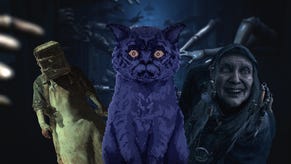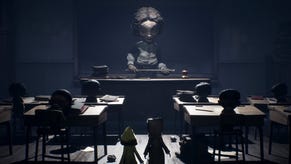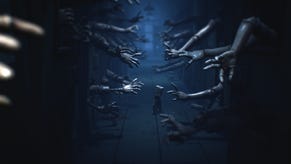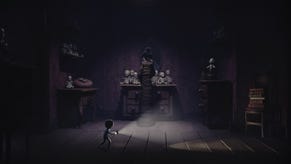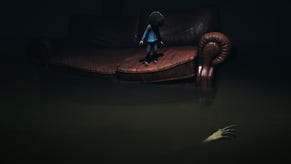Little Nightmares Finds True Fear In Unusual Places
Fully fuelled
It's always an odd experience, playing a horror game in a crowded convention centre. At EGX, I sat down with Little Nightmares [official site] and that it managed to work its way under my skin despite the surroundings is as glowing as any praise I can direct toward this gorgeous, uncanny creation.
The graphics and setting, somewhere between the Grimmest of fairy tales, Dark Water and City of Lost Children, have received a lot of attention, but looks aren't everything. It's the sound design that made me shudder.
You play as a little girl, her face hidden in a hood. She seems to live in a world where every item of furniture is oversized; it'd seem like a jail, built for her, if everything weren't so uncomfortably large. A hand-me-down jail, perhaps, that was once a home.
In the first room, there's a ball to play with, but like everything else, it's so large that you can't exactly ricochet it around the walls. Instead, you can grab it and push it around, or give it a shove to watch it roll. There's a great sense of weight and it was as I explored the first area, mucking around with that ball, that I realised Little Nightmares wasn't Limbo or Inside, but scarier. I'd expected something similar to Playdead's two side-scrolling child-in-peril simulators, but the depth of the environments and reliance on stealth ensure that any comparisons wither quite quickly.
The first stealth section involves a game of hide and seek in a kitchen. You're the one hiding and a sickly cook is the one doing the seeking. He doesn't know you're in the kitchen at all unless you alert him to your presence, either by scuttling across his line of sight or clumsily crashing into a pan or oven door, but one he sees you, the chase begins.
And it's at the moment that I was first spotted that Little Nightmares sent an actual shiver down my spine.
As he moves around the kitchen, preparing a fish for consumption, the cook snuffles and snorts. He sounds extremely ill and his face doesn't look quite complete, as if it's either half-moulded clay or a once-finished article of flesh that has since disintegrated. He's solid though, and a formidable size in comparison to the tiny player character; he was made to fit this world (or it was made to fit him), and we're like a rodent scuttling around on the floor, hiding beneath cabinets and tables.
What I love about the cook character – and this is something I discussed with creators Tarsier after playing – is that he doesn't seem to be a malevolent creature. Watching him shuffle and cough, he seems almost tragic, caught in a mechanical loop of seasoning and gathering utensils. The way that a game character's repeated animations and habits can become strangely horrifying is something that Little Nightmares' designers seem to have a fine understanding of – we're used to NPCs behaving weirdly, but just look at Existenz and the new Westworld series for good examples of how strange those behaviours look taken out of context.
Little Nightmares' characters are firmly within a game-y context, of course, but it's when the cook sights that poor little girl that you're controlling that the situation becomes uncomfortable. You might expect him to whip out a cleaver and chase her down, or to bellow in rage. That would be startling and grotesque, but it wouldn't be as unnerving as what does happen.
He squeals, a sort of distressed noise of surprise and shock, like a pig that has recognised the abattoir. The first time I heard it I didn't associate it with the cook at all. I'd stumbled against some hanging pans and the clang that they let out alerted him to my presence. He shrieked and made a beeline for me, arms outstretched, and I froze.
There are no death animations, not in this early section at least. Once you're caught, he holds you dangling in front of his face, studying you, and the screen fades to black. Then you're back at the entrance of the room to try again.
Even though the kitchen is a small area, there are multiple routes and it's possible to be spotted and survive, by hiding, so the encounter isn't too tightly scripted. But there's not a lot of room to experiment. Eventually, you're either going to cross the space successfully or end up in the cook's clutches.
Once through, there's some clambering to do and a neat puzzle involving strings of sausages and toying with physics. The demo ends shortly afterwards, with a descent into darkness. At the bottom of that darkness there's a sight more troubling than the cook in all his clamminess. Piles of shoes, with more falling from above to add to what is almost a sea of footwear.
It's an image that immediately made me think of the Holocaust, of people being stripped and processed. We don't say the word, when I speak to Tarsier after playing, but during the conversation it's clear that the shift from the bizarre meeting with the (possibly) murderous, cannibalistic chef to more immediately real horrors is intentional. The shoes, which part as something moves through them unseen just as the demo fades out, are a reminder of atrocities, but in and of themselves they are...well, they're just shoes.
Importantly, there's no indication that the player character would make that same connection when confronted with them, and that's how such awful images can exist in a playful world. It's a tricky balancing act but, for me, it was almost perfectly executed.
Little Nightmares is far from the Burtonesque blend of gothic whimsy and dark fairytale that I thought it might be. If it succeeds, and on the slight evidence I've seen it has every chance of succeeding handsomely (and grotesquely), it might well do so by showing us a child's eye view of very real horror. Not just childhood fears manifested, like the clown under the bed, but the terror of the world reduced to elements that might stick in a child's mind. The knowing that something is wrong with a scene or a sight or a person, but not having the knowledge or experience to know why that is.
Sickness and shock in the kitchen, and a sea of shoes. We can't always trace or translate the things that frighten us, as adults as well as in childhood, but Little Nightmares has just enough hooks and threads to follow that I reckon there might be a sinister sense to it all. I can't wait to see more, even if I'm already slightly apprehensive about what I might find.
Tarsier's work on Little Big Planet ports and DLC is evident in the playful physics, but it's the smart approach to horror that I'm excited about. Some years go by without a single scare 'em up of note, and it's good to look into 2017 and know there are already dark corners to be explored.
Little Nightmares is due out in Spring 2017.






